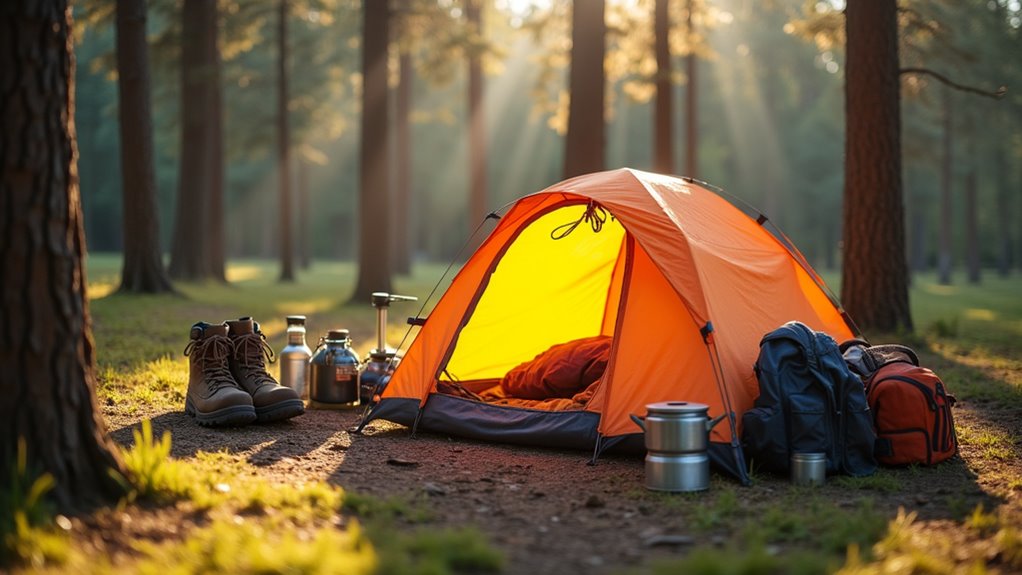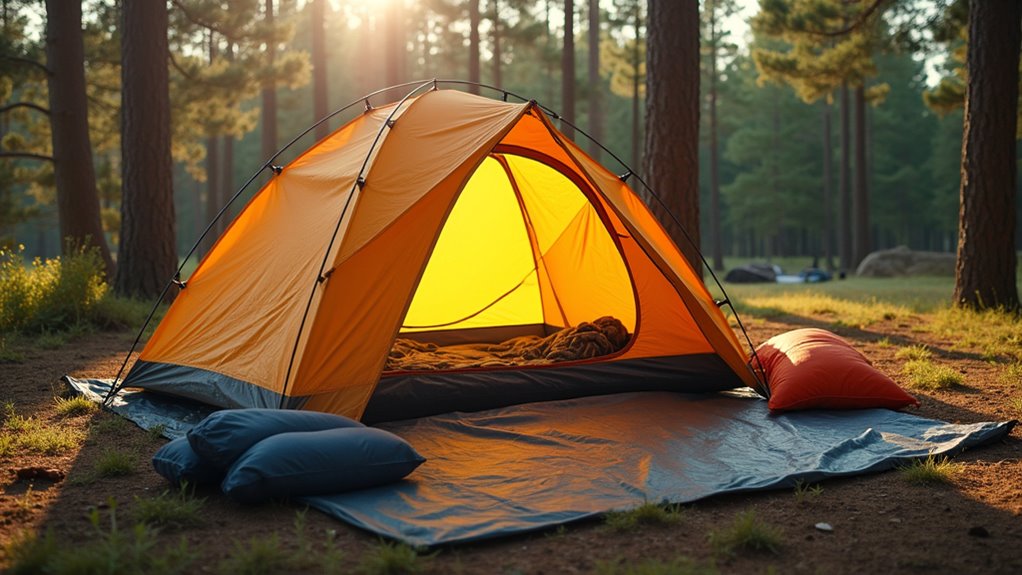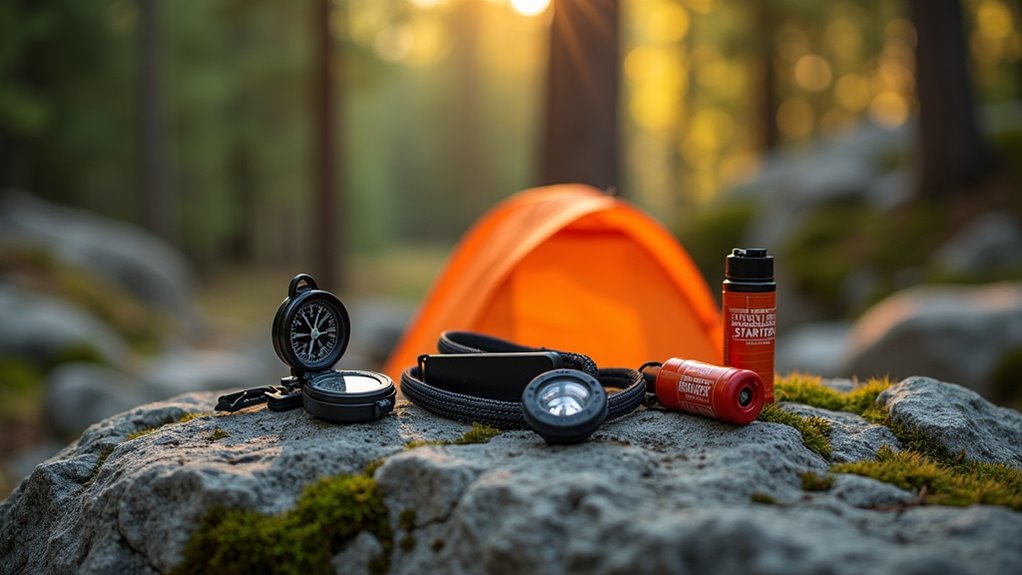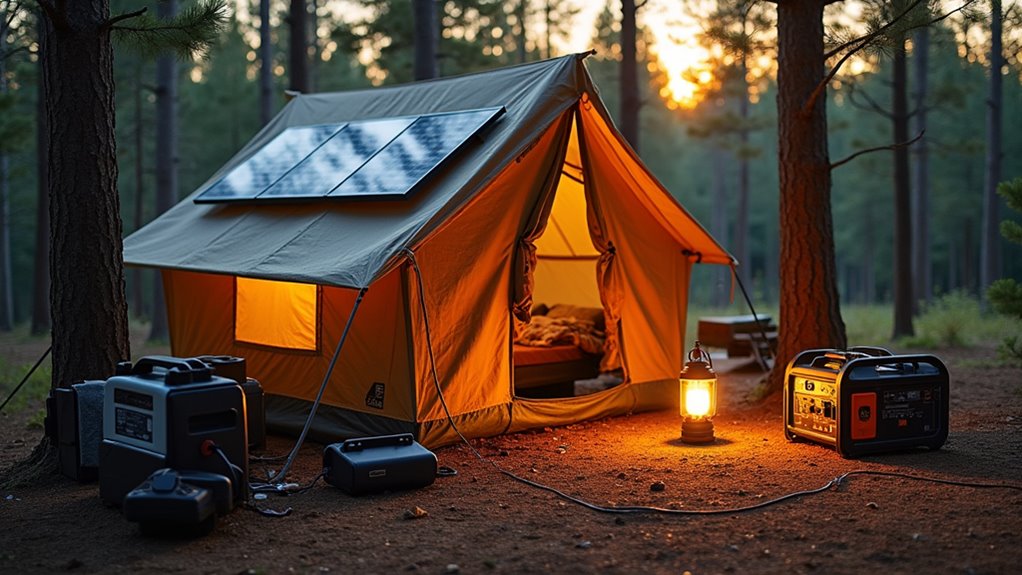Physical Address
304 North Cardinal St.
Dorchester Center, MA 02124
Physical Address
304 North Cardinal St.
Dorchester Center, MA 02124

Before venturing into the wilderness, discover the critical camping essentials that separate successful outdoor adventures from potential disasters.
When you’re preparing to “rough it” in the great outdoors, you’ll quickly discover that successful camping isn’t just about finding a scenic spot and hoping for the best. You need the right gear, proper planning, and essential knowledge to transform your wilderness adventure from potential disaster into comfortable retreat. Without understanding these fundamental requirements, you might find yourself facing unexpected challenges that could turn your peaceful getaway into something far less enjoyable than you’d imagined.

When you’re miles from civilization, your shelter and sleep system become your lifeline against the elements. Your tent serves as your primary defense, so choose one that matches your camping conditions. Three-season tents work for most situations, while four-season models handle harsh weather.
Don’t overlook your sleep system’s three critical components. Your sleeping bag should match the lowest expected temperature, and synthetic fill performs better when wet than down. A quality sleeping pad isn’t just comfort—it’s insulation from ground cold that’ll steal your body heat.
Pack a backup tarp for versatility. It’ll create extra shelter, protect gear, or serve as emergency coverage. Test everything at home first. You don’t want to discover your tent’s missing stakes or your sleeping bag’s zipper sticks when you’re already in the wilderness. Regular tent maintenance will extend your shelter’s lifespan and ensure it performs when you need it most.
After you’ve secured your shelter, your cooking setup determines whether you’ll eat well or go hungry in the backcountry. You’ll need a reliable camp stove with extra fuel canisters, since wood fires aren’t always feasible. Pack lightweight cookware—a single pot and spork often suffice for solo trips. Don’t forget a sharp knife and cutting board for meal prep.
Food storage requires serious planning. Use airtight containers or resealable bags to prevent spoilage and wildlife encounters. Bear canisters are mandatory in many areas, while rope and stuff sacks work for hanging food elsewhere. Pack non-perishable items like pasta, canned goods, and dried fruits.
Bring a cooler with plenty of ice for car camping, but freeze-dried meals work better for backpacking when weight matters most. Consider bringing an essential survival kit that includes compact cooking tools and emergency food supplies to ensure you’re prepared for unexpected situations.

Even if you know the area like the back of your hand, you’ll want reliable navigation tools and safety gear before venturing into the wilderness. Pack a detailed topographic map and compass as your primary navigation system. Don’t rely solely on your smartphone’s GPS since batteries die and signals fail in remote areas.
Your safety kit should include a whistle for emergencies, headlamp with extra batteries, multi-tool, first aid supplies, and emergency shelter like a space blanket. Bring waterproof matches or a reliable fire starter. Consider a personal locator beacon for serious backcountry trips.
Tell someone your planned route and expected return time. Check weather forecasts and trail conditions beforehand. These tools aren’t just recommendations—they’re essential insurance for your safety outdoors. Before finalizing your gear list, take time to determine your camping style preferences to ensure you pack appropriately for your specific outdoor adventure.
While navigation tools keep you safe, proper clothing and personal items make the difference between enduring your camping trip and truly enjoying it. You’ll need layered clothing that adapts to temperature changes—base layers for moisture-wicking, insulating layers for warmth, and outer shells for wind and rain protection.
Pack extra socks and underwear; they’re lightweight but vital for comfort and hygiene. Don’t forget sturdy hiking boots, a warm hat, and waterproof gloves.
Personal items like toiletries, medications, and a quick-dry towel enhance your outdoor experience considerably.
Include a headlamp for hands-free lighting, sunscreen, insect repellent, and a personal first-aid kit. These items transform rough camping into comfortable outdoor living, letting you focus on enjoying nature rather than battling discomfort.
If you’re planning to bring your four-legged companions along, remember that camping with pets requires additional preparation and specialized gear to ensure their safety and comfort in the wilderness.

When you’re planning an extended camping trip, reliable lighting and power sources become essential infrastructure rather than mere conveniences. You’ll need multiple lighting options: headlamps for hands-free tasks, lanterns for area illumination, and backup flashlights. LED options offer the best battery life and durability.
For power, consider portable solar panels paired with power banks or battery stations. These’ll keep your devices charged while remaining environmentally friendly. Gas-powered generators work for high-energy needs but create noise and require fuel storage. A camping generator provides reliable power for extended stays when solar options may not meet all your electrical needs. Don’t forget extra batteries for all devices.
String up solar fairy lights around your campsite for ambient evening lighting. They’re lightweight, weather-resistant, and create a welcoming atmosphere. Always pack backup power sources – extended stays mean you can’t afford lighting failures when darkness falls.
You’ve got the blueprint for camping success in your hands! Remember, each piece of gear serves as a crucial link in your outdoor survival chain—and you’re only as strong as your weakest link. Don’t compromise on essentials like shelter, safety gear, or navigation tools. Start with the basics, test your setup at home, and gradually build your kit. With proper preparation, you’ll transform any wilderness into your temporary home away from home.